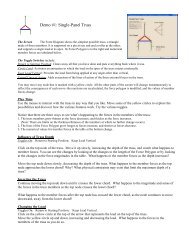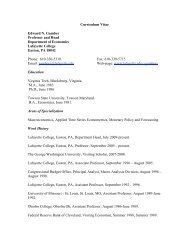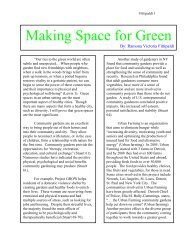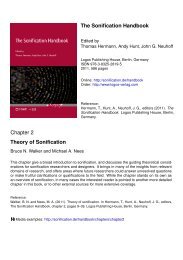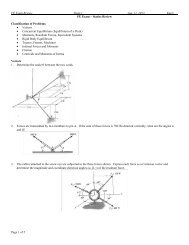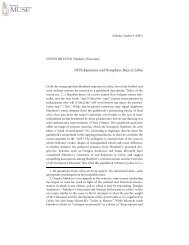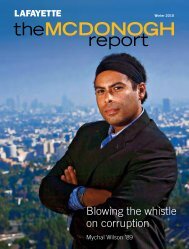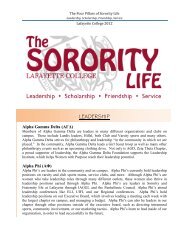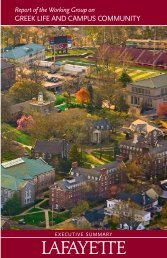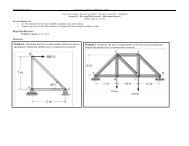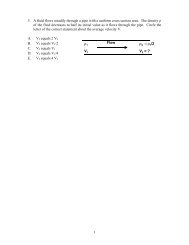1 Works Cited Abramowitz, Alan I. 1997. âThe ... - Sites at Lafayette
1 Works Cited Abramowitz, Alan I. 1997. âThe ... - Sites at Lafayette
1 Works Cited Abramowitz, Alan I. 1997. âThe ... - Sites at Lafayette
Create successful ePaper yourself
Turn your PDF publications into a flip-book with our unique Google optimized e-Paper software.
Cooley, Charles Horton. [1922] 2006. Human N<strong>at</strong>ure and the Social Order. NewBrunswick, NJ: Transaction Publishers.Damasio, Antonio. 1994. Descartes’ Error: Emotion, Reason, and the Human Brain.New York, NY: Penguin Books.D’Antonio, William V. 2007. American C<strong>at</strong>holics Today: New Realities of Their Faithand Their Church. Lanham, MD: Rowman & Littlefield.Dawkins, Richard. 1976. The Selfish Gene. New York, NY: Oxford University Press.Deutsch, Morton and Harold B. Gerard. [1955] 1965. “A Study of Norm<strong>at</strong>ive andInform<strong>at</strong>ional Social Influences upon Individual Judgment.” In Basic Studies inSocial Psychology, eds. Harold Proshansky and Bernard Seidenberg. New York, NY:Holt, Rinehart and Winston.Dionne, E.J., Jr. 2006. “Polarized by God? American Politics and the Religious Divide.”In Red and Blue N<strong>at</strong>ion? Volume One. Characteristics and Causes of America’sPolarized Politics, eds. Pietro S. Nivola and David W. Brady. Washington, D.C.:Brookings / Hoover.Djupe, Paul A. and Christopher P. Gilbert. 2008. The Political Influence of Churches.Cambridge, U.K.: Cambridge University Press.Easton, David and Jack Dennis. 1965. “The Child’s Image of Government.” Annals of theAmerican Academy of Political and Social Science 361, Political Socializ<strong>at</strong>ion: ItsRole in the Political Process (September): 40-57.———. 1967. “The Child’s Acquisition of Regime Norms: Political Efficacy.” TheAmerican Political Science Review 61 (March): 25-38.Elias, Norbert. [1989] 1996. The Germans, ed. Michael Schröter and trans. Eric Dunningand Stephen Mennell. New York, NY: Columbia University Press.Elliot, Andrew J. and P<strong>at</strong>ricia G. Devine. 1994. “On the Motiv<strong>at</strong>ional N<strong>at</strong>ure of CognitiveDissonance: Dissonance as Psychological Discomfort.” Journal of Personality andSocial Psychology 67 (3): 382-394.Ellison, Christopher G. and Darren E. Sherk<strong>at</strong>. 1993. “Obedience and Autonomy:Religion and Parental Values Reconsidered.” Journal for the Scientific Study ofReligion 32 (December): 313-329.Elster, Jon. 1989a. Nuts and Bolts for the Social Sciences. Cambridge, U.K.: CambridgeUniversity Press.4
———. 1989b. The Cement of Society: A Study of Social Order. Cambridge, U.K.:Cambridge University Press.———. 1999. Alchemies of the Mind: R<strong>at</strong>ionality and the Emotions. Cambridge, U.K.:Cambridge University Press.———. 2007. Explaining Social Behavior: More Nuts and Bolts for the Social Sciences.Cambridge, U.K.: Cambridge University Press.Fein, Steven, George R. Goethals, and M<strong>at</strong>thew B. Kugler. 2007. “Social Influence onPolitical Judgments: The Case of Presidential Deb<strong>at</strong>es.” Political Psychology 28(April): 165–192.Feldman, Stanley. 1988. “Structure and Consistency in Public Opinion: The Role of CoreBeliefs and Values.” The American Journal of Political Science 32 (May): 416-440.———. 1999. “Economic Values and Inequality.” In Measures of Political Attitudes,eds. John P. Robinson, Phillip R. Shaver, and Lawrence S. Wrightsman. San Diego,CA: Academic Press.———. 2003a. “Enforcing Social Conformity: A Theory of Authoritarianism.” PoliticalPsychology 24 (March): 41-74.———. 2003b. “Values, Ideology, and the Structure of Political Attitudes.” In OxfordHandbook of Political Psychology, eds. David O. Sears, Leonie Huddy, and RobertJervis. New York, NY: Oxford University Press.Feldman, Stanley and Marco R. Steenbergen. 2001. “The Humanitarian Found<strong>at</strong>ion ofPublic Support for Social Welfare.” American Journal of Political Science 45 (July):658-677.Festinger, Leon. 1950. “Informal Social Communic<strong>at</strong>ion.” Psychological Review 57:271-282.———. 1957. A Theory of Cognitive Dissonance. Evanston, IL: Row, Peterson.Fiorina, Morris P. 2006. Culture War? The Myth of a Polarized America (Second ed.).New York, NY: Pearson Longman.Fischhoff, Baruch, Roxana M. Gonzalez, Jennifer S. Lerner, and Deborah A. Small.2005. “Evolving Judgments of Terror Risks: Foresight, Hindsight, and Emotion.”Journal of Experimental Psychology: Applied 11 (June): 124-139.Fiske, Susan T. 2004. Social Beings: A Core Motives Approach to Social Psychology.Hoboken, NJ: John Wiley & Sons.5
Fredrickson, Barbara L. 1998. “Cultiv<strong>at</strong>ed Emotions: Parental Socializ<strong>at</strong>ion of PositiveEmotions and Self-Conscious Emotions.” Psychological Inquiry 9 (4): 279-281.Gerber, <strong>Alan</strong> S., Donald P. Green, and Christopher W. Larimer. 2008. “Social Pressureand Vote Turnout: Evidence from a Large-Scale Field Experiment.” AmericanPolitical Science Review 102 (February): 19-31.Gibbard, Allan. 1990. Wise Choices, Apt Feelings: A Theory of Norm<strong>at</strong>ive Judgment.Cambridge, MA: Harvard University Press.Goffman, Erving. 1959. The Present<strong>at</strong>ion of Self in Everyday Life. New York, NY:Anchor Books.Grant, J. Tobin and Thomas J. Rudolph. 2003. “Value Conflict, Group Affect, and theIssue of Campaign Finance.” American Journal of Political Science 47 (July): 453-469.Gurin, P<strong>at</strong>ricia and Aloen Townsend. 1986. “Properties of Gender Identity and TheirImplic<strong>at</strong>ions for Gender Consciousness.” British Journal of Social Psychology 25(June): 139-148.Hansen, Christine H. and Cynthia A. Shantz. 1995. “Emotion-specific Priming:Congruence Effects on Affect and Recognition Across Neg<strong>at</strong>ive Emotions.”Personality and Social Psychology Bulletin 21 (June): 548-557.Hardin, Russell. 1995. One for All: The Logic of Group Conflict. Princeton, NJ: PrincetonUniversity Press.Hartz, Louis. 1955. The Liberal Tradition in America. New York, NY: Harcourt Brace.Herzog, Don. 1998. Poisoning the Minds of the Lower Orders. Princeton, NJ: PrincetonUniversity Press.Hobbes, Thomas. [1651] 1994. Levi<strong>at</strong>han, ed. Edwin Curley. Indianapolis: HackettPublishing Company.Hochschild, Jennifer L. 1981. Wh<strong>at</strong>’s Fair? American Beliefs about Distributive Justice.Cambridge, MA: Harvard University Press.Horowitz, Donald L. 1985. Ethnic Groups in Conflict. Berkeley, CA: University ofCalifornia Press.Howe, Neil, William Strauss, and R.J. M<strong>at</strong>son. 2000. Millennials Rising: The Next Gre<strong>at</strong>Gener<strong>at</strong>ion. New York, NY: Vintage Books.6
Huckfeldt, Robert, Paul E. Johnson, and John Sprague. 2004. Political Disagreement:The Survival of Diverse Opinions within Communic<strong>at</strong>ion Networks. Cambridge, U.K.:Cambridge University Press.Huckfeldt, Robert and John Sprague. 1995. Citizens, Politics, and SocialCommunic<strong>at</strong>ion: Inform<strong>at</strong>ion and Influence in an Election Campaign. Cambridge,U.K.: Cambridge University Press.Huddy, Leonie, Stanley Feldman, and Erin Cassese. 2007. “On the Distinct PoliticalEffects of Anxiety and Anger.” In The Affect Effect: The Dynamics of Emotion inPolitical Thinking and Behavior, eds. Russell W. Neuman, George E. Marcus,Michael MacKuen, and Ann N. Crigler. Chicago, IL: University of Chicago Press.Huddy, Leonie and Nadia Kh<strong>at</strong>ib. 2007. “American P<strong>at</strong>riotism, N<strong>at</strong>ional Identity, andPolitical Involvement.” American Journal of Political Science 51 (January): 63-77.Hume, David. [1739/1740] 2000. A Tre<strong>at</strong>ise of Human N<strong>at</strong>ure, eds. David F<strong>at</strong>e Nortonand Mary J. Norton. Oxford, U.K.: Oxford University Press.Hunter, James Davison. 1991. Culture Wars: The Struggle to Define America. New York,NY: Basic Books.Huntington, Samuel P. 1981. American Politics: The Promise of Disharmony.Cambridge, MA: Harvard University Press.———. 2004. Who Are We? The Challenges to America’s N<strong>at</strong>ional Identity. New York,NY: Simon and Schuster.Inglehart, Ron. 1971. “The Silent Revolution in Europe.” The American Political ScienceReview 65 (December): 991-1017.Inglehart, Ron and Wayne Baker. 2000. “Moderniz<strong>at</strong>ion, Cultural Change, and thePersistence of Traditional Values.” American Sociological Review 65 (February): 19-51.Jacoby, William G. 2006. “Value Choices and American Public Opinion.” AmericanJournal of Political Science 50 (July): 706-723.Jennings, M. Kent and Richard Niemi. 1981. Gener<strong>at</strong>ions and Politics: A Panel Study ofYoung Adults and Their Parents. Princeton, NJ: Princeton University Press.Jennings, M. Kent, Laura Stoker, and Jake Bowers. 2007. “Politics Across Gener<strong>at</strong>ions:Family Transmission Reexamined.” ms.K<strong>at</strong>z, Elihu and Paul F. Lazarsfeld. 1955. Personal Influence: The Part Played by Peoplein the Flow of Mass Communic<strong>at</strong>ions. Glencoe, IL: Free Press.7
Kaufmann, Karen M. and John R. Petrocik. 1999. “The Changing Politics of AmericanMen: Understanding the Sources of the Gender Gap.” American Journal of PoliticalScience 43 (July): 864-887.Kelley, Harold H. 1955. “Salience of Membership and Resistance to Change of Group-Anchored Attitudes.” Human Rel<strong>at</strong>ions 8: 275-289.Kinder, Donald R. and Tali Mendelberg. 2000. “Individualism Reconsidered: Principlesand Prejudice in Contemporary American Opinion.” In Racialized Politics: TheDeb<strong>at</strong>e about Racism in America, eds. David O. Sears, Jim Sidanius, and LawrenceBobo. Chicago, IL: University of Chicago Press.Kinder, Donald R. and Lynn M. Sanders. 1996. Divided by Color: Racial Politics andDemocr<strong>at</strong>ic Ideals. Chicago, IL: University of Chicago Press.Kinder, Donald R. and David O. Sears. 1985. “Public Opinion and Political Actions.” InThe Handbook of Social Psychology, eds. Gardner Lindzey and Elliot Aronson. NewYork, NY: Random House.Kluckhohn, Clyde. 1951. “Values and Value Orient<strong>at</strong>ions in the Theory of Action.” InToward a General Theory of Action, eds. T. Parsons and E. A. Shils. Cambridge,MA: Harvard University Press.Kluegel, James R. and Eliot R. Smith. 1986. Beliefs about Inequality: Americans’ Viewsof Wh<strong>at</strong> Is and Wh<strong>at</strong> Ought to Be. New York, NY: Aldine de Gruyter.Kohut, Andrew, John C. Green, Scott Keeter, and Robert C. Toth. 2000. The DiminishingDivide: Religion’s Changing Role in American Politics. Washington, D.C.:Brookings.Kuklinski, James H., Ellen Riggle, Victor Ott<strong>at</strong>i, Norbert Schwarz, and Robert S. Wyer,Jr. 1991. “The Cognitive and Affective Bases of Political Tolerance Judgments.”American Journal of Political Science 35 (February): 1-27.Langer, Gary and Jon Cohen. 2005. “Voters and Values in the 2004 Election.” PublicOpinion Quarterly 69 (Special Issue): 744-759.Layman, Geoffrey and Thomas M. Carsey. 1998. “Why Do Party Activists Convert? AnAnalysis of Individual-Level Change on the Abortion Issue.” Political ResearchQuarterly 51 (3): 723-749.Lazarus, Richard S. 1991. Emotion and Adapt<strong>at</strong>ion. Oxford, U.K.: Oxford UniversityPress.LeDoux, Joseph. 1996. The Emotional Brain: The Mysterious Underpinnings ofEmotional Life. New York, NY: Touchstone.8
Leege, David C. 2001. “Religion and Politics (United St<strong>at</strong>es).” In Intern<strong>at</strong>ionalEncyclopedia of the Social & Behavioral Sciences, eds. Neil J. Smelser and Paul B.Baltes. New York, NY: Elsevier.Leege, David C., Kenneth D. Wald, Brian S. Krueger, and Paul D. Mueller. 2002. ThePolitics of Cultural Differences: Social Change and Voter Mobiliz<strong>at</strong>ion Str<strong>at</strong>egies inthe Post-New Deal Period. Princeton, NJ: Princeton University Press.Lerner, Jennifer S., Roxana M. Gonzalez, Deborah A. Small, and Baruch Fischhoff.2003. “Effects of Fear and Anger on Perceived Risks of Terrorism: A N<strong>at</strong>ional FieldExperiment.” Psychological Science 14 (March): 144-150.Lerner, Jennifer S., Deborah Small, and George Loewenstein. 2004. “Heart Strings andPurse Strings: Carryover Effects of Emotions on Economic Decisions.” PsychologicalScience 15 (May): 337-341.LeVine, Robert A. and Donald T. Campbell. 1972. Ethnocentrism: Theories of Conflict,Ethnic Attitudes, and Group Behavior. New York, NY: John Wiley & Sons.Lewis, Michael. 2000. “Self-conscious Emotions: Embarrassment, Pride, Shame, andGuilt.” In Handbook of Emotions (Second ed.), eds. Michael Lewis and Jeannette M.Haviland-Jones. New York, NY: Guilford Press.Lipset, Seymour Martin. 1963. The First New N<strong>at</strong>ion: The United St<strong>at</strong>es in Historicaland Compar<strong>at</strong>ive Perspective. New York, NY: Basic Books.MacKinnon, David P., Amanda J. Fairchild, and M<strong>at</strong>thew S. Fritz. 2007. “Medi<strong>at</strong>ionAnalysis.” Annual Review of Psychology 58: 593-614.Marcus, George E., W. Russell Neuman, and Michael MacKuen. 2000. AffectiveIntelligence and Political Judgment. Chicago, IL: University of Chicago Press.Markus, Greg. 2001. “American Individualism Reconsidered.” In Citizens and Politics:Perspectives from Political Psychology, ed. James H. Kuklinski. Cambridge, U.K.:Cambridge University Press.Mascolo, Michael F. and Kurt W. Fischer. 1995. “Developmental Transform<strong>at</strong>ions inAppraisals for Pride, Shame, and Guilt.” In Self-Conscious Emotions: ThePsychology of Shame, Guilt, Embarrassment, and Pride, eds. June Price Tangney andKurt W. Fischer. New York, NY: Guilford Press.M<strong>at</strong>z, David C. and Wendy Wood. 2005. “Cognitive Dissonance in Groups: TheConsequences of Disagreement.” Journal of Personality and Social Psychology 88(January): 22-37.9
McClosky, Herbert and John Zaller. 1984. The American Ethos. Cambridge, MA:Harvard University Press.McConkey, Dale. 2001. “Whither Hunter’s Culture War? Shifts in Evangelical Morality,1988-1998.” Sociology of Religion 62 (Summer): 149-174.McNair, Maurice Lorr and Leo F. Droppleman. 1971. Profile of Mood St<strong>at</strong>es. San Diego,CA: Educ<strong>at</strong>ional and Industrial Testing Service.Mendelberg, Tali. 2001. The Race Card: Campaign Str<strong>at</strong>egy, Implicit Messages, and theNorm of Equality. Princeton, NJ: Princeton University Press.Meyer, Peter. 2007. “Can C<strong>at</strong>holic Schools Be Saved?” Educ<strong>at</strong>ion Next 7 (Spring).Milgram, Stanley. 1992. The Individual in a Social World: Essays and Experiments(Second ed.). New York, NY: McGraw-Hill, Inc.Mill, J.S. [1859] 1980. On Liberty. New York, NY: Penguin Books.Mills, C. Wright. 1959. The Sociological Imagin<strong>at</strong>ion. Oxford, U.K.: Oxford UniversityPress.Miller, William Ian. 1990. Bloodtaking and Peacemaking: Feud, Law, and Society inSaga Iceland. Chicago, IL: University of Chicago Press.———. 1993. Humili<strong>at</strong>ion. Ithaca, NY: Cornell University Press.———. <strong>1997.</strong> The An<strong>at</strong>omy of Disgust. Cambridge, MA: Harvard University Press.Moskalenko, Sophia, Clark McCauley, and Paul Rozin. 2006. “Group Identific<strong>at</strong>ionUnder Conditions of Thre<strong>at</strong>: College Students’ Attachment to Country, Family,Ethnicity, Religion, and University Before and After September 11, 2001.” PoliticalPsychology 27 (February): 77-97.Mulligan, Kenneth. 2008. “The ‘Myth’ of Moral Values Voting in the 2004 PresidentialElection.” PS: Political Science & Politics 41 (January): 109-114.Mutz, Diana C. 1998. Impersonal Influence: How Perceptions of Mass Collectives AffectPolitical Attitudes. Cambridge, U.K.: Cambridge University Press.———. 2006. Hearing the Other Side: Deliber<strong>at</strong>ive versus Particip<strong>at</strong>ory Democracy.Cambridge, U.K.: Cambridge University Press.Myrdal, Gunnar. [1944] 1964. An American Dilemma. New York, NY: McGraw-Hill.10
Nagourney, Adam and Megan Thee. 2007. “Young Americans Are Leaning Left, NewPoll Finds.” New York Times, June 27.Newcomb, Theodore. 1963. “Persistence and Regression of Changed Attitudes: Long-Range Studies.” Journal of Social Issues 19 (4): 3-14.Nelson, Thomas E., Rosalee A. Clawson, Zoe M. Oxley. <strong>1997.</strong> “Media Framing of aCivil Liberties Conflict and Its Effect on Tolerance.” American Political ScienceReview 91 (September): 567-583.Nickerson, David W. 2008. “Is Voting Contagious? Evidence from Two FieldExperiments.” American Political Science Review 102 (February): 49-57.Noelle-Neuman, Elizabeth. 1993. The Spiral of Silence: Public Opinion – Our SocialSkin (Second ed.). Chicago, IL: University of Chicago Press.Nussbaum, Martha C. 2001. Upheavals of Thought: The Intelligence of Emotions.Cambridge, U.K.: Cambridge University Press.———. 2004. Hiding from Humanity: Disgust, Shame, and the Law. Princeton, NJ:Princeton University Press.O’Keefe, Daniel J. 1990. Persuasion: Theory and Research. Newbury Park, CA: SagePublic<strong>at</strong>ions.Parker, Suzanne L., Glenn R. Parker, and James A. McCann. 2008. “Opinion Takingwithin Friendship Networks.” American Journal of Political Science 52 (April): 412-420.Peffley, Mark, Pia Knigge, and Jon Hurwitz. 2001. “A Multiple Values Model ofPolitical Tolerance.” Political Research Quarterly 54 (June): 379-406.Pei, Minxin. 2003. “The Paradoxes of American N<strong>at</strong>ionalism.” Foreign Policy 136(May/June): 30-37.Peltola, Pia, Melissa A. Milkie, and Stanley Presser. 2004. “The ‘Feminist’ Mystique:Feminist Identity in Three Gener<strong>at</strong>ions of Women.” Gender and Society 18(February): 122-144.Petty, Richard E. and John T. Cacioppo. 1986. “The Elabor<strong>at</strong>ion Likelihood Model ofPersuasion.” Advances in Experimental Psychology 19: 124-205.Pew Research Center. 2008. “A Portrait of American C<strong>at</strong>holics on the Eve of PopeBenedict’s Visit.” Washington, D.C.: Pew Research Center Public<strong>at</strong>ions.11
Prendergast, William B. 1999. The C<strong>at</strong>holic Voter in American Politics: The Passing ofthe Democr<strong>at</strong>ic Monolith. Washington, D.C.: Georgetown University Press.Prothro, James W. and Charles M. Grigg. 1960. “Fundamental Principles of Democracy:Bases of Agreement and Disagreement.” The Journal of Politics 22 (May): 276-294.Putnam, Robert D. 1994. Making Democracy Work: Civic Traditions in Modern Italy.Princeton, NJ: Princeton University Press.Rescher, Nicholas. [1969] 1982. Introduction to Value Theory. Englewood Cliffs, NJ:Prentice-Hall, Inc.Richerson, Peter J. and Robert Boyd. 2005. Not by Genes Alone: How CultureTransformed Human Evolution. Chicago, IL: Chicago University Press.Rokeach, Milton. 1973. The N<strong>at</strong>ure of Human Values. New York, NY: The Free Press.Rosenstone, Steven J. and John Mark Hansen. 1993. Mobiliz<strong>at</strong>ion, Particip<strong>at</strong>ion, andDemocracy in America. New York, NY: MacMillan.Rousseau, Jean-Jacques. [1762] 1988. “On Social Contract.” In Rousseau’s PoliticalWritings, eds. <strong>Alan</strong> Ritter and Julia Conaway Bondanella and trans. Julia ConawayBondanella. New York, NY: W.W. Norton.Sapiro, Virginia. 2003. “Theorizing Gender in Political Psychology Research.” In OxfordHandbook of Political Psychology, eds. David O. Sears, Leonie Huddy, and RobertJervis. Oxford, U.K.: Oxford University Press.Saxe, Rebecca and Johannes Haushofer. 2008. “For Love or Money: A Common NeuralCurrency for Social and Monetary Reward.” Neuron 58: 164-165.Saxonhouse, Arlene. 2005. Free Speech and Democracy in Ancient Athens. Cambridge,U.K.: Cambridge University Press.Scheff, Thomas. 1988. “Shame and Conformity: The Deference-Emotion System.”American Sociological Review 53 (June): 395-406.Schuman, Howard. 2006. “Letter to the Editor.” Public Opinion Quarterly 70 (Fall): 413-415.Schwartz, Shalom H. 1992. “Universals in the Content and Structure of Values:Theoretical Advances and Empirical Tests in 20 Countries.” Advances inExperimental Social Psychology 25: 1-65.12
Sears, David O. 1993. “Symbolic Politics: A Socio-Psychological Theory.” InExplor<strong>at</strong>ions in Political Psychology, eds. Shanto Iyengar and William J. McGuire.Durham, NC: Duke University Press.Sears, David O. and Sheri Levy. 2003. “Childhood and Adult Political Development.” InOxford Handbook of Political Psychology, eds. David O. Sears, Leonie Huddy, andRobert Jervis. Oxford, U.K.: Oxford University Press.Sears, David and Nicholas A. Valentino. <strong>1997.</strong> “Politics M<strong>at</strong>ters: Political Events asC<strong>at</strong>alysts for Preadult Socializ<strong>at</strong>ion.” American Political Science Review 91 (March):45-65.Shapiro, Robert Y. and Harpreet Mahajan. 1986. “Gender Differences in PolicyPreferences: A Summary of Trends From the 1960s to the 1980s.” The PublicOpinion Quarterly 50 (Spring): 42-61.Sherif, Muzafer. [1936] 1966. The Psychology of Social Norms. New York, NY: Harper& Row.Sigel, Roberta. 1989. Political Learning in Adulthood: A Sourcebook of Theory andResearch. Chicago, IL: University of Chicago Press.Small, Deborah A. and Jennifer S. Lerner. 2005. “Emotional Policy: Personal Sadnessand Anger Shape Judgments about a Welfare Case.” Political Psychology 29 (April):149-168.Small, Deborah A., Jennifer S. Lerner, and Baruch Fischhoff. 2006. “Emotion Primingand Attributions for Terrorism: Americans' Reactions in a N<strong>at</strong>ional FieldExperiment.” Political Psychology 27 (April): 289-298.Small, Deborah A., George Loewenstein, and Paul Slovic. 2007. “Symp<strong>at</strong>hy andCallousness: The Impact of Deliber<strong>at</strong>ive Thought on Don<strong>at</strong>ions to Identifiable andSt<strong>at</strong>istical Victims.” Organiz<strong>at</strong>ional Behavior and Human Decision Processes 102:143-153.Smith, Adam. [1759] 2002. The Theory of Moral Sentiments, ed. D.D. Raphael and A.L.Macfie. Indianapolis, IN: Liberty Fund.Smith, Rogers M. <strong>1997.</strong> Civic Ideals: Conflicting Visions of Citizenship in U.S. History.New Haven, CT: Yale University Press.Smith, Tom W. and Lars Jarkko. 1998. N<strong>at</strong>ional Pride: A Cross-n<strong>at</strong>ional Analysis. GSSCross-n<strong>at</strong>ional Report No. 19. Chicago, IL: N<strong>at</strong>ional Opinion Research Center /University of Chicago.13
Sniderman, Paul M. and Edward G. Carmines. <strong>1997.</strong> Reaching Beyond Race. Cambridge,MA: Harvard University Press.Sniderman, Paul M. and Thomas Piazza. 1993. The Scar of Race. Cambridge, MA:Harvard University Press.Stenner, Karen. 2005. The Authoritarian Dynamic. Cambridge, U.K.: CambridgeUniversity Press.Stoker, Laura. 1992. “Interests and Ethics in Politics.” The American Political ScienceReview 86 (June): 369-380.———. 2001. “Political Value Judgments.” In Citizens and Politics: Perspectives fromPolitical Psychology, ed. James H. Kuklinski. Cambridge, U.K.: CambridgeUniversity Press.Stoker, Laura and M. Kent Jennings. 2005. “Political Similarity and Influence betweenHusbands and Wives.” In The Social Logic of Politics: Personal Networks asContexts for Political Behavior, ed. <strong>Alan</strong> S. Zuckerman. Philadelphia, PA: TempleUniversity Press.Suhay, Elizabeth, N<strong>at</strong>han Kalmoe, and Christa McDermott. 2007. “Why Twin StudiesAre Problem<strong>at</strong>ic for the Study of Political Ideology: Rethinking Are PoliticalOrient<strong>at</strong>ions Genetically Transmitted?” ms.Sumner, William Graham. [1907] 2002. Folkways: A Study of Mores, Manners, Customsand Morals. Mineola, NY: Dover Public<strong>at</strong>ions.Tajfel, Henri and John C. Turner. [1986] 2004. “The Social Identity Theory of IntergroupBehavior.” In Political Psychology: Key Readings, eds. John T. Jost and JimSidanius. New York, NY: Taylor & Francis Books.Tangney, June Price and Kurt W. Fischer, eds. 1995. Self-Conscious Emotions: ThePsychology of Shame, Guilt, Embarrassment, and Pride. New York, NY: TheGuilford Press.Tetlock, Philip E. 2000. “Coping with Trade-Offs: Psychological Constraints andPolitical Implic<strong>at</strong>ions.” In Elements of Reason: Cognition, Choice, and the Bounds ofR<strong>at</strong>ionality, eds. Arthur Lupia, M<strong>at</strong>hew D. McCubbins, and Samuel L. Popkin.Cambridge, U.K.: Cambridge University Press.Tetlock, Philip E., Randall S. Peterson, and Jennifer S. Lerner. 1996. “Revising the ValuePluralism Model: Incorpor<strong>at</strong>ing Social Content and Context Postul<strong>at</strong>es.” In ThePsychology of Values: The Ontario Symposium, Vol. 8, eds. Clive Seligman, JamesM. Olson, and Mark P. Zanna. Mahwah, NJ: Lawrence Erlbaum.14
de Tocqueville, Alexis. [1835/1840] 2004. Democracy in America, trans. ArthurGoldhammer. New York, NY: The Library of America.Transue, John E. 2007. “Identity Salience, Identity Acceptance, and Racial PolicyAttitudes: American N<strong>at</strong>ional Identity as a Uniting Force.” American Journal ofPolitical Science 51 (January): 78-91.Turner, John C. 1987. Rediscovering the Social Group: A Self-C<strong>at</strong>egoriz<strong>at</strong>ion Theory.New York, NY: Blackwell.———. 1991. Social Influence. Bristol, PA: Open University Press.Valentino, Nicholas A., Vincent L. Hutchings, Antoine J. Banks, and Anne K. Davis.2008. “Is a Worried Citizen a Good Citizen? Emotions, Political Inform<strong>at</strong>ion Seekingand Learning via the Internet.” Political Psychology 29 (April): 247-273.Valentino, Nicholas, Vincent Hutchings, Krysha Gregorowicz, Eric Groenendyk, and TedBrader. 2006. “Election Night’s Alright for Fighting: Fear, Anger, and PoliticalParticip<strong>at</strong>ion.” Paper presented <strong>at</strong> the 2006 American Political Science Associ<strong>at</strong>ionAnnual Conference.Verba, Sidney and Gary R. Orren. 1985. Equality in America: The View from the Top.Cambridge, MA: Harvard University Press.Vitello, Paul. 2008. “After Ground Zero Prayer, Pope Ministers to 60,000 in Stadium.”The New York Times. April 21.Wald, Kenneth D., Dennis E. Owen, and Samuel S. Hill, Jr. “Churches as PoliticalCommunities.” 1988. The American Political Science Review 82 (June): 531-548.Walsh, K<strong>at</strong>herine Cramer. 2004. Talking about Politics: Informal Groups and SocialIdentity in American Life. Chicago, IL: Chicago University Press.Weber, Max. [1930] 1992. The Protestant Ethic and the Spirit of Capitalism. New York,NY: Routledge.White, John Kenneth. 2003. The Values Divide: American Politics and Culture inTransition. New York, NY: Ch<strong>at</strong>ham House Publishers.Winkielman, Piotr, Robert B. Zajonc, and Norbert Schwarz. <strong>1997.</strong> “Subliminal AffectivePriming Resists Attributional Interventions.” Cognition and Emotion 11 (July): 433-465.Wolfe, <strong>Alan</strong>. 2006. “Myths and Realities of Religion in Politics. Comment.” In Red andBlue N<strong>at</strong>ion? Volume One. Characteristics and Causes of America’s Polarized15
Politics, eds. Pietro S. Nivola and David W. Brady. Washington, D.C.: Brookings /Hoover.Wood, Wendy, Gregory J. Pool, Kira Leck, and Daniel Purvis. 1996. “Self-definition,Defensive Processing, and Influence: The Norm<strong>at</strong>ive Impact of Majority andMinority Groups.” Journal of Personality and Social Psychology 71 (December):1181-1193.Zajonc, Robert B. 1980. “Feeling and Thinking: Preferences Need No Inferences.”American Psychologist 35 (February): 151-175.Zuckerman, <strong>Alan</strong> S. 2005. “Returning to the Social Logic of Political Behavior.” In TheSocial Logic of Politics: Personal Networks as Contexts for Political Behavior, ed.<strong>Alan</strong> S. Zuckerman. Philadelphia, PA: Temple University Press.16



